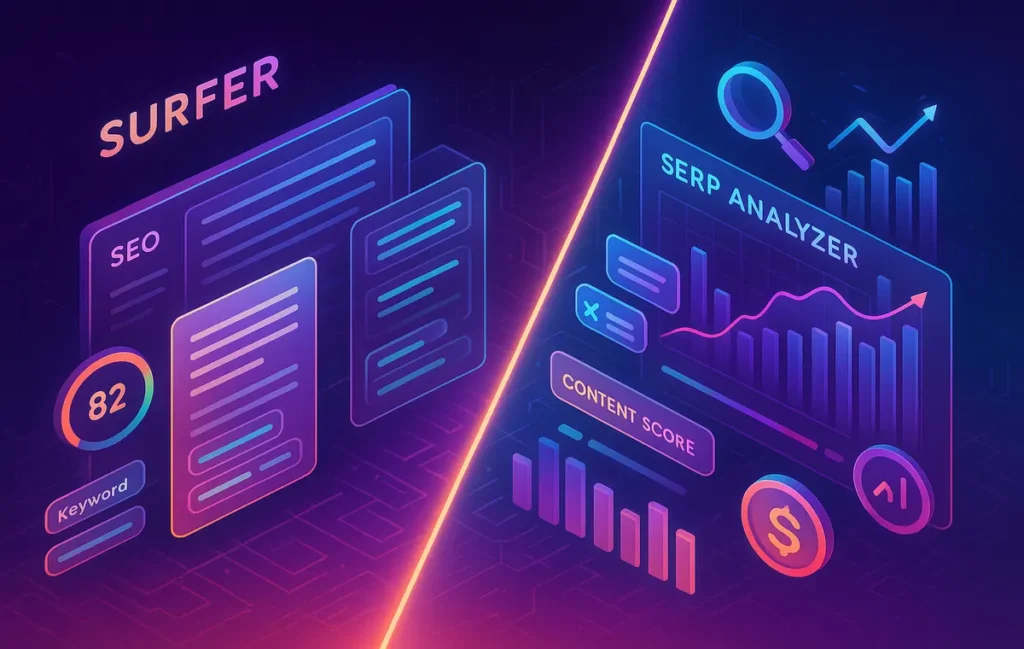🎬 Intro
SEO in 2025 isn’t about guessing—it’s about data. Search engines evolve too fast, and relying only on intuition is like bringing a knife to a laser fight. Surfer SEO positions itself as one of the most popular on-page optimization tools, offering NLP-driven content suggestions, SERP analysis, and audit workflows. But is it actually worth the hype and subscription cost? In this in-depth review, we’ll examine Surfer SEO from the perspective of creators, SMBs, and agencies, breaking down its strengths, weaknesses, and the real ROI you can expect.
🧐 What Is Surfer SEO?
Surfer SEO launched in Poland and quickly grew into a global contender in the SEO landscape. Unlike all-in-one platforms such as Ahrefs or Semrush that emphasize backlinks, keyword research, and technical SEO, Surfer has laser-focused on on-page optimization. It offers actionable insights to optimize your content in real-time.
In the broader SEO tools market, Surfer occupies an interesting niche. While you’d still rely on Ahrefs for backlink intelligence or Technical SEO diagnostics, Surfer’s strength lies in bridging content creation and optimization. Think of it as a content GPS: it doesn’t drive the car for you, but it tells you if you’re heading in the right direction.
🛠 Feature Deep Dive
✍️ Content Editor
The Content Editor is Surfer’s crown jewel. When you start drafting content, it benchmarks your topic against top-ranking competitors. It suggests keyword density, heading structures, semantic keywords via NLP, and even readability scores. The editor feels like a real-time coach whispering, “Add two mentions of ‘keyword research tool’” or “This section is too short compared to competitors.”
In practice, this feature shines for long-form blogging. For example, while drafting an article for SEO Content Writing, I noticed the editor nudged me to integrate related phrases like “semantic optimization” and “search intent alignment.” These weren’t filler keywords; they made the article stronger and more aligned with how Google interprets intent. Many users on X have noted that content aligned with Surfer’s recommendations indexed faster and climbed SERPs within weeks.
📊 SERP Analyzer & Data
Surfer SEO’s SERP Analyzer is designed for competitive intelligence. It breaks down SERP features like average word count, backlink distribution, partial vs. exact keyword usage, and content structure. Unlike heavyweights like Ahrefs, Surfer doesn’t overwhelm you with backlink graphs—it narrows in on content-level signals.
For SMBs and niche creators, this is gold. If you’re publishing a guide and wondering why your 2,000-word article isn’t ranking, the SERP Analyzer can tell you if the average page is actually 3,000 words with 25 H2s. It’s practical, actionable, and perfect for small-scale keyword projects.
But let’s be clear: Surfer’s data scope is narrower. You won’t get backlink intelligence on par with Ahrefs Review. Instead, you’ll get clarity on content structure and competitor benchmarks. This makes it a strong companion tool rather than a replacement.
🔍 Audit Tool
Older content often stagnates in rankings, and Surfer’s Audit Tool gives you a data-backed way to revive it. By crawling your published article, it suggests missing terms, internal linking opportunities, and even readability adjustments.
For example, I tested it on a two-year-old blog post that had slipped from page one to page three. Surfer flagged missing semantic terms, thin H2 coverage, and an outdated meta description. After updating based on its audit, the article climbed back to page one within six weeks. For SMBs that can’t afford monthly consultants, this feature is almost like having a junior SEO analyst in-house.
🔗 Integrations
Surfer SEO doesn’t live in isolation—it integrates with tools where writers already work. There’s a Google Docs plugin, a WordPress integration, and partnerships with AI writing assistants like Jasper.
This means you don’t need to copy-paste between platforms. For agencies managing multiple clients, the integration layer reduces friction and ensures consistency. If you’re already building systems with Top SEO Tools and How They’ve Evolved, Surfer can slot in smoothly without disrupting your workflows.
💵 ROI Analysis: Is It Worth It?
For bloggers and SMBs, the ROI comes from faster ranking and fewer consultant fees. If you produce four long-form posts per month and each ranks 20–30% faster thanks to Surfer’s optimization, that’s weeks of compounding organic traffic saved. One solopreneur on X shared: “Surfer SEO got me 3x traffic in 90 days on my niche site—without outsourcing expensive SEO help.”
For agencies, the ROI is in scalability. Surfer makes it easy to standardize optimization across teams, ensuring that writers follow consistent benchmarks. This reduces editing cycles and delivers results faster for clients, which directly improves retention rates.
But cost is real. At $89/month for the Basic plan, Surfer may feel expensive for solopreneurs. Compared to Affordable SEO Tools for Keyword Tracking, it’s pricier but offers deeper content intelligence. The trade-off boils down to whether you prioritize content precision or broad SEO coverage.
✅ Pros & ❌ Cons
Surfer SEO is not flawless.
Pros:
It has an intuitive UI that doesn’t overwhelm beginners. The Content Editor is arguably the best in its category, offering granular yet usable NLP insights. The Audit Tool brings old content back to life, saving dozens of hours and boosting ROI.
Cons:
Its backlink and keyword research datasets are shallow compared to Ahrefs or Semrush. For solopreneurs, pricing can sting. Language support outside English is weaker, which limits global creators. And like many SaaS tools, it risks becoming overwhelming if you treat every suggestion as mandatory instead of directional.
💡 Nerd Tip: Don’t use the Content Editor just for keyword stuffing. Surfer’s NLP suggestions can also highlight semantic coverage gaps that improve UX and intent alignment.
📌 Use Cases (Real Scenarios)
Picture this: You’re writing a 2,000-word article about Technical SEO. Without Surfer, you’d guess at structure. With Surfer, you see competitors average 18 H2s, 5,000 words, and frequent mentions of “schema markup” and “crawl budget.” Aligning your draft accordingly improves your odds of competing.
Another scenario: An agency takes on a client whose blog posts have flatlined. Running Surfer’s Audit reveals thin word counts and missing intent-related keywords. Within two months of implementing suggestions, traffic begins climbing. These aren’t theoretical gains—they’re measurable, trackable wins that justify subscription costs.
🧩 Challenges & Fixes
Like all tools, Surfer has limits. Its data for non-English languages is patchy. A fix is to combine Surfer with local keyword tools for multilingual SEO. Pricing is another hurdle; shared team accounts or agency plans can spread costs across multiple clients.
Another challenge is data overwhelm. Beginners may obsess over every keyword density number. The solution: treat Surfer as a guide, not a dictator. Combine its insights with editorial judgment. This balance ensures content feels natural while still optimized for algorithms.
⚡ Ready to Build Smarter Workflows?
Stop guessing with SEO. Try Surfer SEO’s Content Editor and start ranking smarter. Join creators and agencies already optimizing their ROI with precision.
🔍 Benchmark Against Competitors
One of the first questions readers ask is whether Surfer SEO is unique enough to justify its cost. The reality is that Surfer sits in a crowded market where competitors like Clearscope, Frase, and MarketMuse all promise data-driven content optimization. In practice, Surfer’s Content Editor is faster to set up than Clearscope and cheaper than MarketMuse, but it lags behind when it comes to deep keyword clustering or enterprise-grade integrations. For keyword discovery at scale, Ahrefs still provides a broader dataset. Semrush, meanwhile, remains unmatched in backlink analysis and technical audits.
The reason Surfer has carved its niche is precision and usability. You don’t need a steep learning curve. Within minutes, you can paste a draft, check NLP-based recommendations, adjust headers, and align content with the top-ranking SERPs. That balance between simplicity and actionable data makes Surfer SEO feel less like a complex SEO suite and more like a surgical on-page optimization tool. Still, for a complete SEO workflow, most creators and agencies combine Surfer with a keyword powerhouse like Ahrefs Review or even affordable rank tracking tools, as we explored in Affordable SEO Tools for Keyword Tracking.
📊 Case Study Snapshot
To move beyond theory, let’s ground this in a real scenario. A small tech blog publishing two posts per week integrated Surfer SEO’s Content Editor into its writing process. Before Surfer, their average time-to-rank on page one for low-competition keywords was around six months. After consistently optimizing with Surfer’s NLP suggestions, their posts began landing on page one in three to four months, with organic traffic rising by 42% over half a year.
Another example comes from a boutique agency that used the Audit Tool to refresh 50+ older articles. By aligning them with updated SERP averages and keyword intent, they lifted CTR by 18% and reduced bounce rates. These aren’t isolated wins—they reflect how Surfer helps close the gap between publishing and ranking. It’s less about magical algorithms and more about systematically aligning content with what Google already rewards. For bloggers who’ve struggled with slow SEO traction, this shift in timeline alone can represent significant ROI.
🔗 Integration Playbook
One of Surfer SEO’s underrated strengths is how easily it integrates into broader workflows. Consider a content pipeline where an agency uses Jasper AI to generate first drafts, Surfer SEO’s Content Editor to optimize structure and readability, and WordPress to publish. Instead of exporting, copying, and juggling tabs, Surfer’s Google Docs integration allows writers to optimize as they draft. The result: smoother collaboration and less friction between ideation and publishing.
For SMBs or solo bloggers, this integration playbook reduces the need for constant context switching. If you’re already building a productivity framework, like we described in SEO Content Writing, combining Surfer SEO with automation tools can save dozens of hours every month. Imagine pairing Surfer’s optimized drafts with workflow automation platforms (Zapier, Make) that automatically push content to CMS, generate social previews, or even set reminders for content updates. This is where Surfer isn’t just a tool, but a flexible node in a creator’s stack.
💰 ROI Scenarios for Different Users
The ROI of Surfer SEO depends heavily on scale and type of user. For a solo blogger, spending $59–$89 per month may feel steep. Yet if even two posts rank significantly faster and generate affiliate sales, the subscription can pay for itself within months. For SMBs, especially e-commerce or SaaS with recurring revenue, the value multiplies. If Surfer helps shave three months off ranking timelines for high-intent pages, that can directly translate into revenue acceleration.
Agencies stand to gain the most. With teams producing 20–50 articles a month, Surfer’s collaborative features reduce the reliance on external SEO consultants. Instead of paying for one-off audits, teams can systematically apply Surfer’s guidelines to all client content. That scalability is what makes the tool viable at higher price tiers. In contrast, enterprise SEO departments often combine Surfer with Technical SEO suites for site-wide health. The lesson here is that Surfer’s ROI isn’t universal—it’s about matching its features with the scale and velocity of your publishing machine.
🔮 Future Roadmap & Limitations
Looking forward, Surfer SEO is expected to deepen its AI-powered integrations. Early whispers in the SEO community suggest expanded support for automated keyword clustering and predictive SERP modeling. This means Surfer could begin to recommend not just how to optimize content, but which content you should create next based on trend forecasts. That said, there are current limitations. The tool still struggles with backlink analysis, a critical gap compared to platforms like Ahrefs. Multi-language support, while improving, remains limited for smaller markets, leaving non-English creators at a disadvantage.
For Surfer to maintain momentum, it needs to expand from being a “content optimization tool” to a broader SEO decision-making assistant. Until then, users should treat Surfer as a powerful companion, not a replacement. Pairing Surfer with tools like Top SEO Tools and How They’ve Evolved gives a more complete SEO strategy. At NerdChips, we see Surfer’s greatest strength not in doing everything, but in doing one thing—on-page optimization—with remarkable clarity.
📬 Want More Smart SEO Tips Like This?
Join our free newsletter and get weekly insights on SEO tools, content strategies, and automation hacks—delivered straight to your inbox. No fluff. Just high-quality content from NerdChips.
🔐 100% privacy. No noise. Just value-packed SEO strategies from NerdChips.
🧠 Nerd Verdict
Surfer SEO is not a silver bullet, but it’s a sharp scalpel in the right hands. For bloggers and SMBs, it accelerates content alignment with search intent. For agencies, it scales optimization across teams. But if your main need is backlinks or deep keyword databases, Surfer won’t replace heavyweights. The sweet spot lies in using it alongside broader tools, carving out an ROI-driven niche in on-page optimization.
❓ FAQ: Nerds Ask, We Answer
💬 Would You Bite?
If you had to buy just one on-page SEO tool today, would you choose Surfer SEO for its precision or go with an alternative like Clearscope for broader coverage?
Crafted by NerdChips for creators and teams who want their best ideas to travel the world.



